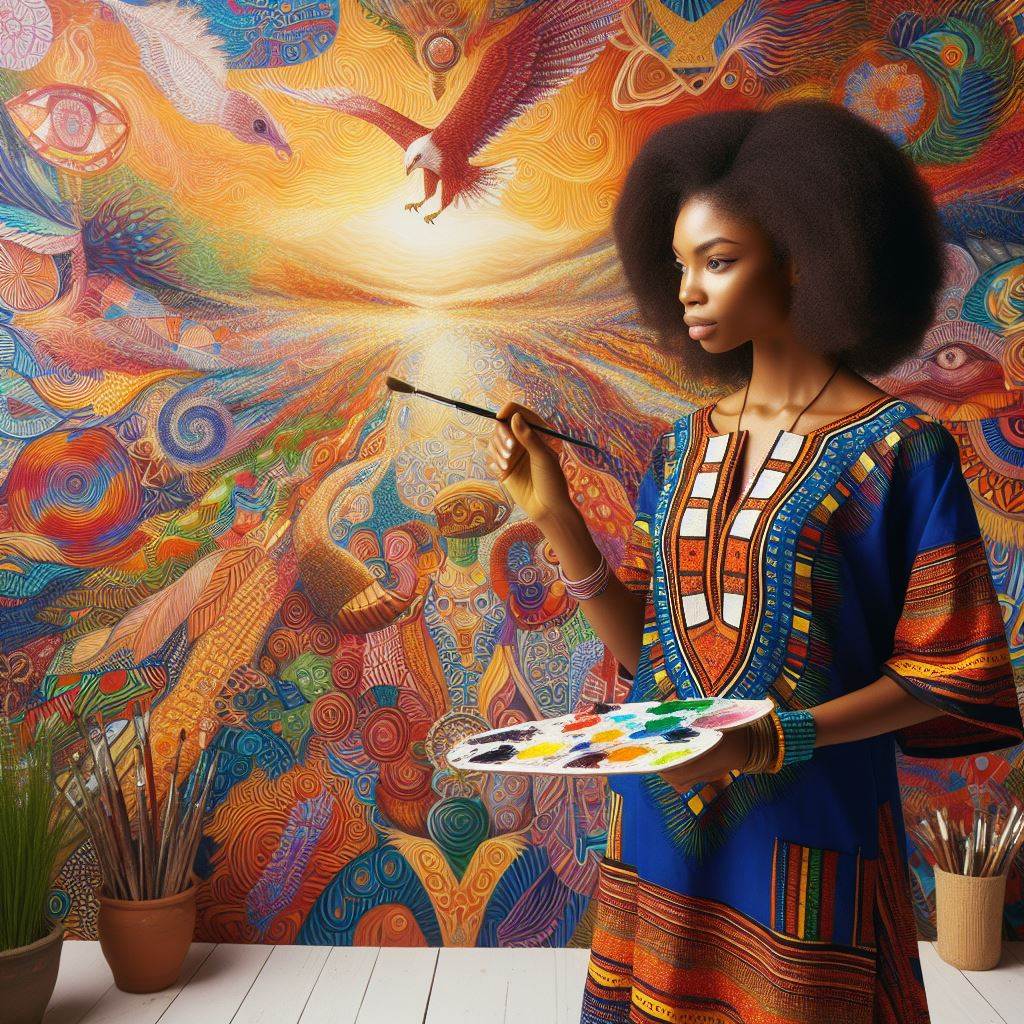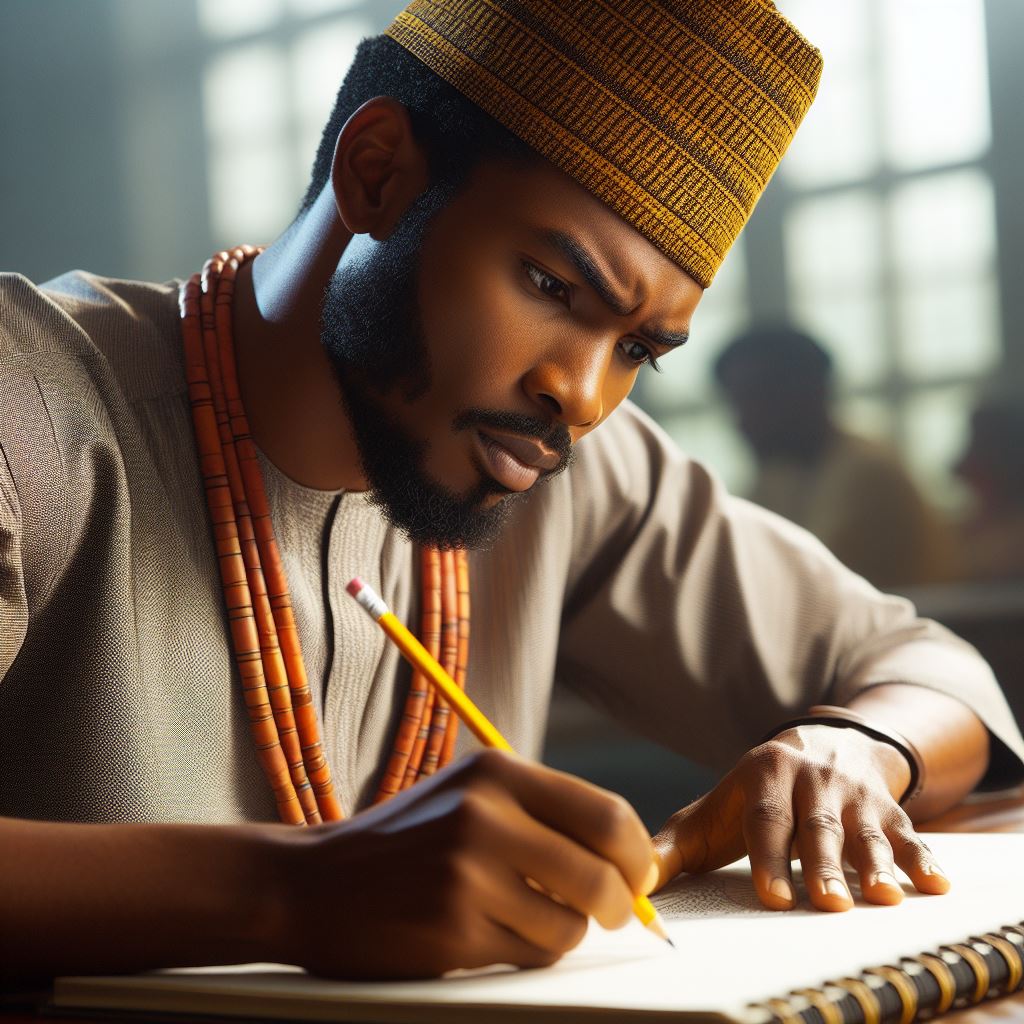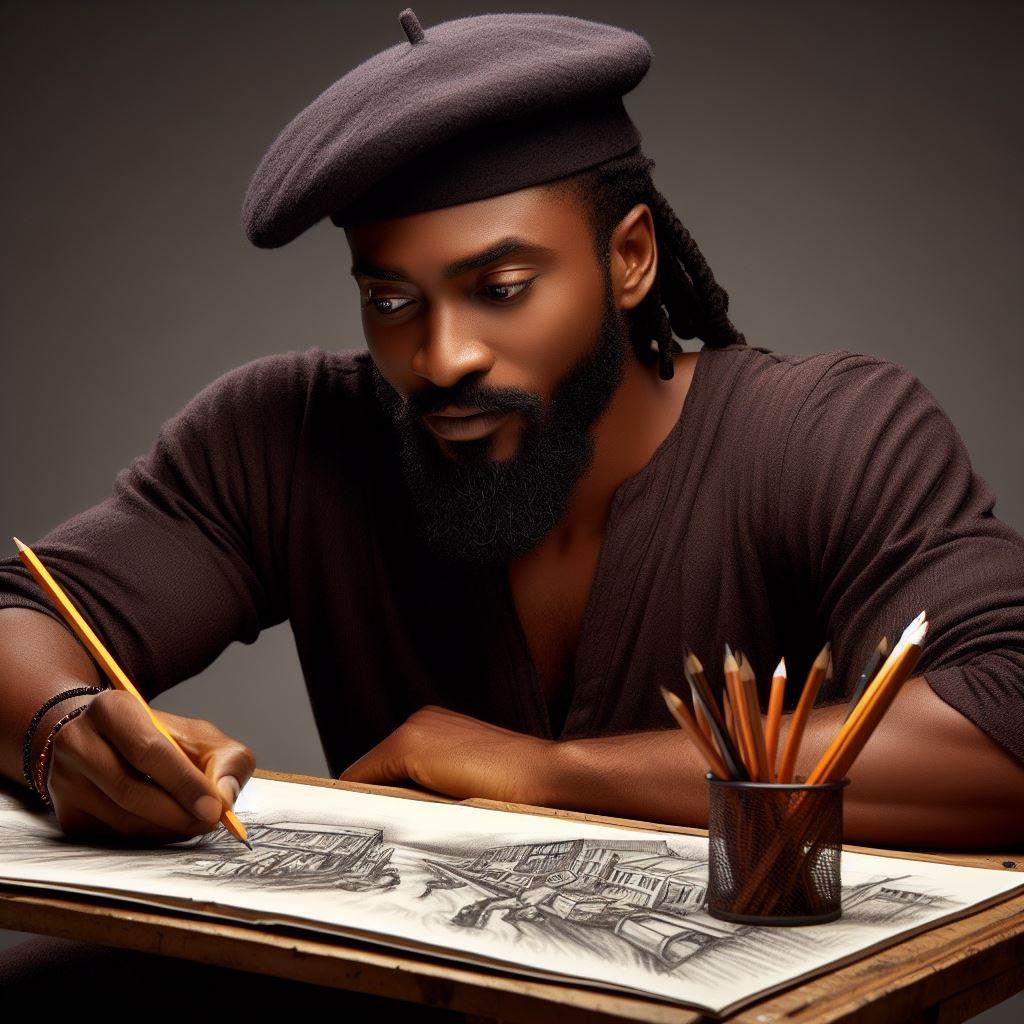Introduction
Introduction: Nigeria’s cultural landscape is adorned with a tapestry of artistic expressions, woven intricately through its history and Nigeria Art History and Heritage
Nigeria’s artistic legacy spans millennia, from ancient civilizations like Nok and Ife to 20th-century art movements.
The country’s diverse ethnic groups contribute to a kaleidoscope of traditions, each with its unique artistic language.
Brief overview of Nigeria’s rich art history and heritage: Nigeria’s art history is as diverse as its people.
The ancient terracotta sculptures of the Nok civilization, dating back to 500 BC, showcase early artistic prowess.
The exquisite bronze and terracotta heads of Ife represent a pinnacle of African sculpture.
Traditional art forms such as beadwork, textiles, and pottery continue to thrive, preserving age-old techniques and motifs.
Exploring and understanding Nigeria’s cultural heritage is more than an art journey; it’s understanding the nation’s soul.
Each artifact tells a story, offering glimpses into the beliefs, values, and aspirations of Nigeria’s past and present generations.
By exploring and understanding Nigeria’s cultural heritage, we gain a deeper appreciation for the country’s diversity, resilience, and creative spirit.
Exploring Nigeria’s Rich Art History and Heritage
Pre-colonial art traditions in Nigeria
Before Europeans arrived, Nigeria had a vibrant art scene with traditional forms reflecting cultural diversity.
Traditional art forms
Woodcarving, pottery, and textile weaving were some of the primary art forms practiced in pre-colonial Nigeria.
These art forms were not only functional but also aesthetic, serving both utilitarian and decorative purposes.
Influence of indigenous beliefs and practices
The creation of art in pre-colonial Nigeria was heavily influenced by indigenous beliefs and practices.
Artworks often depicted scenes from mythology, religious rituals, and everyday life, showcasing the rich cultural heritage of the people.
Examples of famous pre-colonial Nigerian artworks
- Benin Bronzes: These intricately designed brass sculptures were created by the Edo people of Benin City and are renowned for their artistic quality and historical significance.
- Nok Terracottas: The Nok culture of ancient Nigeria is famous for its distinctive terracotta sculptures, which date back to as early as 500 BC.
- Ife Bronzes: The Ife kingdom in southwestern Nigeria produced exquisite bronze and terracotta sculptures that are considered masterpieces of African art.
Overall, pre-colonial Nigerian art traditions were diverse, vibrant, and deeply rooted in the cultural heritage of the people.
These traditional art forms continue to inspire contemporary Nigerian artists and serve as a testament to the country’s rich artistic legacy.
Read: Developing Critical Thinking in Language Arts
Colonial and post-colonial influences on Nigerian art
Impact of colonialism on traditional art forms and practices
During the colonial period, Nigerian traditional art forms and practices were heavily influenced by European styles and techniques.
Colonizers imposed Western aesthetic norms, forcing indigenous artists to adapt and resulting in a decline of Nigerian art’s authenticity.
Traditional art forms like wood carving, pottery making, and textile weaving were marginalized in favor of European art forms like painting and sculpture.
However, despite the negative impact of colonialism on traditional Nigerian art, it also paved the way for the emergence of new art styles and movements in post-colonial Nigeria.
Emergence of new art styles and movements in post-colonial Nigeria
After gaining independence from British rule in 1960, Nigerian artists began to reclaim and redefine their artistic identity.
This period marked a significant shift in the art scene, with the emergence of new art styles and movements that reflected the cultural and political realities of post-colonial Nigeria.
One of the most notable art movements to emerge during this time was the Nsukka School, founded by a group of artists at the University of Nigeria, Nsukka.
The Nsukka School sought to break free from the constraints of colonial art and explore new forms of artistic expression rooted in Nigerian traditions.
Artists who have played a significant role in shaping Nigeria’s art scene
- Ben Enwonwu: Known as the “father of Nigerian modernism,” Ben Enwonwu is one of the most influential Nigerian artists of the 20th century. His iconic sculptures and paintings have made a lasting impact on the Nigerian art scene.
- El Anatsui: Renowned for his large-scale installations made from discarded materials, El Anatsui is a celebrated Nigerian artist whose work has gained international recognition. His art challenges traditional notions of beauty and materiality.
- Peju Alatise: A multidisciplinary artist, Peju Alatise has made significant contributions to the Nigerian art scene through her thought-provoking installations and sculptures. Her work often explores themes of gender, identity, and social issues.
- Yinka Shonibare: Internationally acclaimed for his use of Dutch wax fabric in his sculptures and installations, Yinka Shonibare explores themes of colonialism, globalization, and cultural identity in his work. He is a prominent figure in the contemporary Nigerian art scene.
Therefore, the colonial and post-colonial influences on Nigerian art have shaped the country’s rich art history and heritage.
Colonialism’s impact on traditional art was detrimental but also paved the way for new styles in post-colonial Nigeria.
Ben Enwonwu, El Anatsui, Peju Alatise, and Yinka Shonibare shape Nigeria’s art scene and inspire future generations.
Read: Student Experiences: Life in Communication Arts
Nigerian Contemporary Art Scene
Overview of Modern Nigerian Artists and Their Works
Nigeria has a vibrant contemporary art scene that is making waves both locally and internationally. Artists like Njideka Akunyili Crosby, Victor Ekpuk, and Peju Alatise are gaining recognition for their innovative works.
These artists use painting, sculpture, installation, and mixed media to explore themes deeply rooted in Nigerian culture and history.
Their works often reflect on issues such as identity, politics, gender, and social justice, showcasing the diversity and complexity of the Nigerian experience.
Themes and Messages in Contemporary Nigerian Art
Contemporary Nigerian art features a rich tapestry of themes and messages that resonate with both local and global audiences.
Artists draw inspiration from Nigerian folklore, mythology, and traditional practices, reinterpreting them to address contemporary issues in modern contexts.
Njideka Akunyili Crosby explores cultural hybridity and diaspora, while Victor Ekpuk uses ancient Nsibidi symbols for universal truths.
These artists create visually stunning works and use their art as a platform to engage with social and political issues.
Global Recognition and Awards Received by Nigerian Artists
Nigerian artists have been receiving increasing recognition on the global stage, with many winning prestigious awards and participating in major exhibitions around the world.
Njideka Akunyili Crosby received the MacArthur Fellowship in 2017 and recently hosted a solo exhibition at the National Portrait Gallery in London.
Victor Ekpuk’s work has been exhibited at the Smithsonian National Museum of African Art. He was commissioned to create a mural for the United Nations General Assembly Hall.
Nigerian artists’ talent and creativity are showcased, highlighting the growing appreciation for African art in the international art world.
Read: How to Apply for Communication Arts Programs

Uncover the Details: How to Start a Blog as a Mass Communication Student
Uncover the Details: Prominent Historical Events in Nigerian Curriculum
Preservation and promotion of Nigerian art heritage
Efforts by the government and cultural organizations to preserve Nigerian art
- The government has established agencies like the National Commission for Museums and Monuments to protect and preserve Nigerian art.
- Cultural organizations such as the Society of Nigerian Artists work towards promoting and safeguarding traditional and contemporary Nigerian art.
- Funding and grants are provided by the government to support artists and art institutions in their conservation efforts.
Role of museums and galleries in showcasing Nigerian art to the world
- Nigerian museums like the National Gallery of Art in Lagos serve as platforms to display and educate the public on Nigerian art history.
- Galleries in Nigeria and abroad exhibit Nigerian artworks, attracting international collectors, tourists, and scholars to appreciate the country’s cultural heritage.
- Virtual exhibitions hosted by museums and galleries facilitate global access to Nigerian art, promoting cultural exchange and dialogue.
Challenges faced in preserving and promoting Nigerian art heritage
- Lack of adequate funding and infrastructure hinders conservation efforts, leading to neglect of historic sites and artworks.
- Political instability and insecurity in certain regions pose threats to art preservation and limit public engagement with cultural heritage.
- Issues of authenticity and provenance surrounding Nigerian art sometimes hinder its recognition and market value on a global scale.
Overall, the preservation and promotion of Nigeria’s rich art history and heritage require collaborative efforts from the government, cultural institutions, and the public to ensure the safeguarding and appreciation of the country’s diverse artistic legacy.
Read: Famous Nigerian Alumni of Communication Arts Programs
You Might Also Like: Economics and Environmental Sustainability in Nigeria
See Related Content: Postgraduate Economics Programs in Nigeria
Impact of Nigerian art on society
How Nigerian art reflects the country’s cultural diversity and history
Nigerian art mirrors the nation’s kaleidoscope of cultures, blending Yoruba, Igbo, Hausa, and other ethnic influences.
Each artwork tells stories of tradition, mythology, and daily life, embodying Nigeria’s rich cultural tapestry.
Nigerian art, from intricate beadwork to vibrant textile designs, celebrates its people’s diversity and honors centuries-old traditions.
Influence of Nigerian art on social and political issues
Nigerian art serves as a powerful tool for social commentary and political expression.
Artists use their craft to address pressing issues such as corruption, inequality, and human rights abuses. Through paintings, sculptures, and performance art, they challenge societal norms, provoke thought, and inspire change.
Iconic works like Ben Enwonwu’s “Anyanwu” and Bruce Onobrakpeya’s “Olokun Priest” confront viewers with Nigerian society’s complexities, sparking dialogue and driving social transformation.
Educational value of studying Nigerian art and its impact on future generations
Studying Nigerian art offers invaluable educational opportunities, providing insights into history, culture, and societal dynamics.
By examining artistic techniques, themes, and symbolism, students gain a deeper understanding of Nigeria’s past and present.
Moreover, exposure to Nigerian art fosters cultural appreciation, empathy, and cross-cultural understanding among future generations.
Art education inspires young minds to explore their creativity, preserving Nigeria’s artistic heritage for posterity.
Generally, exploring Nigeria’s rich art history and heritage unveils a captivating tapestry of culture, tradition, and creativity.
Nigerian art, with its diverse ethnic influences and profound social and political impact, testifies to the nation’s resilience and dynamism.
Studying Nigerian art deepens our appreciation for its cultural significance and empowers future generations to shape a brighter, inclusive future.
Gain More Insights: Anthropology and Environmental Issues in Nigeria
Conclusion
Recap of the importance of exploring Nigeria’s rich art history and heritage: Nigeria’s art is a reflection of its diverse culture and history, offering invaluable insights into its identity.
From ancient terracotta sculptures to contemporary masterpieces, each artwork tells a story of resilience, creativity, and cultural richness.
Call to action for promoting and supporting Nigerian artists and art institutions: Let’s champion Nigerian artists by sharing their work, attending exhibitions, and investing in local art.
By supporting Nigerian art institutions, we ensure the preservation and promotion of Nigeria’s artistic legacy for future generations to appreciate and enjoy.
Encouragement for readers to further explore and appreciate Nigeria’s artistic legacy: Dive deeper into Nigeria’s artistic treasures to uncover the beauty and significance of its cultural heritage.
Whether through visiting galleries, exploring online collections, or engaging with local artists, there are countless ways to immerse oneself in Nigeria’s vibrant artistic landscape.
Join us in celebrating the creativity and diversity of Nigerian art!




